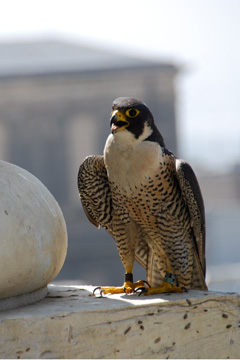 story by Berrnard BrownLook up, Philadelphia. Study the clock tower at City Hall and the tops of our Center City skyscrapers to witness the high drama unfolding above the concrete and asphalt. Here the air’s top predators are flying high over rooftops and knocking their prey from the sky at 200 miles per hour.
story by Berrnard BrownLook up, Philadelphia. Study the clock tower at City Hall and the tops of our Center City skyscrapers to witness the high drama unfolding above the concrete and asphalt. Here the air’s top predators are flying high over rooftops and knocking their prey from the sky at 200 miles per hour.
If you had been looking up from South Broad Street on May 23, you might have seen me. I was stationed just beneath the face of the clock on City Hall, holding a broom. I had been commissioned to protect Dr. F. Arthur McMorris, peregrine falcon coordinator for the Pennsylvania Game Commission, who was tagging a brood of four young peregrine falcons, fastening bands on their legs for future identification. My job was simple: use the broom to discourage the furious parents from attacking. Lucky for me, this only amounted to standing my ground as the parents glared from the balustrade a yard away, then ominously flew a couple blocks out, turning and coming back for another run.
But who was I to keep the falcons from attacking? These are the fastest animals on the planet (topping 200 miles per hour in a dive), with a streamlined form, fierce eyes and clean-edged, slate gray head patterns that look like war paint. The pair in Philadelphia imposes a no-fly zone for a mile around City Hall: no other falcons may pass; seagulls take a wide detour across Center City. Their talons impale pigeons and ducks. I had a broom.
Later, the adult falcons glared through the windows into the tower as McMorris measured the young and clipped bands onto their legs, and veterinarian Keith Hinshaw, the Philadelphia Zoo’s Director of Animal Health, looked them over. As a new father myself, I empathized with the mom and dad. How would I feel if giant monsters yanked my daughter from her crib and manhandled her while she screamed in terror?
Peregrine falcons have an unusual relationship with humans. In the mid-1900s, DDT devastated the population and, by 1961, there were no breeding pairs east of the Rockies.
After reintroductions into what’s considered their “natural” habitat failed in the 1980s (for example, great horned owls picked off the newly released falcons), biologists noticed that urban canyons mimicked peregrines’ natural habitat, complete with an ample supply of pigeons.
Though peregrines are thriving at City Hall and nest under pretty much every bridge across the Delaware, this is a habitat of convenience. “Quite frankly, nesting on man-made structures is not safe,” says McMorris. Plenty of fledgling falcons meet their end by smacking into an office window. Still, enough young peregrines disperse after they leave the nest to keep the overall population expanding.
Before DDT became popular in the late 1940s there were on average 44 pairs of falcons in Pennsylvania nesting on natural cliffs. Now, we have just 32 pairs in the state with about one quarter living in the Philadelphia area. “This isn’t a very large number,” says McMorris, “but we’re thrilled since it’s more than the last year.”
Bernard Brown is an amateur field herper, bureaucrat and founder of the PB&J Campaign (pbjcampaign.org), a movement focused on the benefits of eating lower on the food chain. Read about his forays into the natural world at phillyherping.blogspot.com.


